Walking through Saint-Jean-de-Luz feels like entering a world of Basque Country cuisine. The smell of cinnamon-laced gâteau Basque comes from bakeries. The Atlantic breeze brings the smell of fresh sardines.
This coastal town mixes French elegance with Basque boldness. It offers dishes like ttoro fisherman’s soup and axoa’s herb-kissed veal. As you explore this region, you see its food as a mix of tradition and adventure.
For American food lovers, Saint-Jean-de-Luz is a treasure. Its markets are full of marmitako tuna stews and piperade’s colorful peppers. This Saint-Jean-de-Luz food guide shows how it keeps old recipes while trying new things. Every bite here tells a story of Basque fishermen, family taverns, and dishes passed down through generations.
Key Takeaways
- Discover how Saint-Jean-de-Luz merges Atlantic seafood with land-inspired Basque staples
- Learn to navigate local markets where vendors still use century-old trading rituals
- Uncover the history behind iconic dishes like ttoro soup and cherry-filled gâteau Basque
- Understand the region’s commitment to sustainable seafood practices
- Explore how French and Spanish flavors coexist in every bite
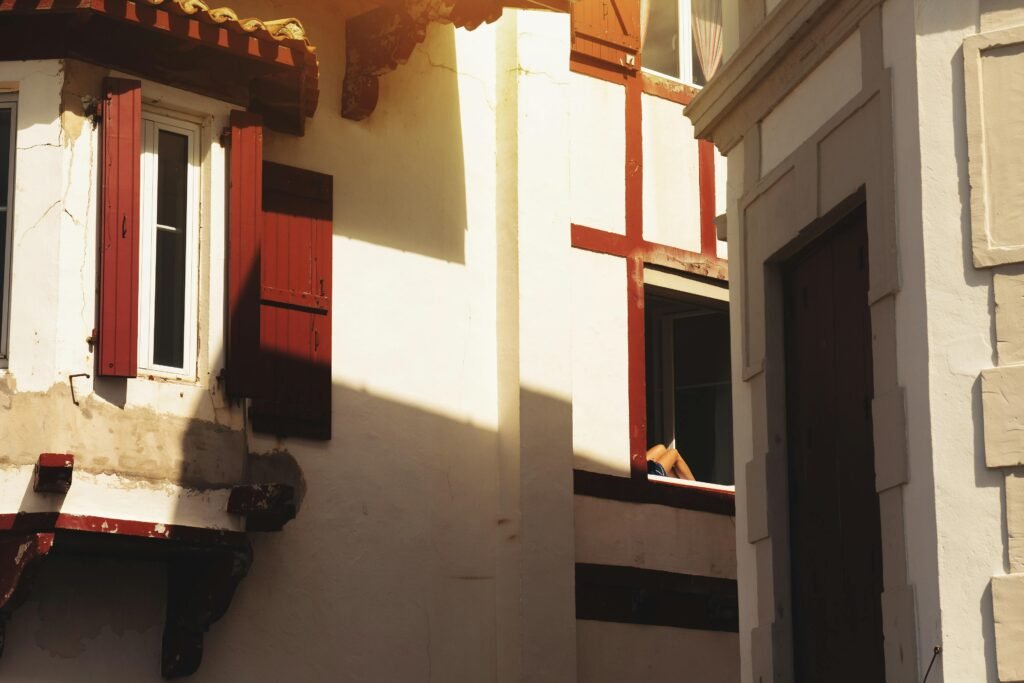
Introduction to Saint-Jean-de-Luz: A Culinary Haven in French Basque Country
Walking the cobblestone streets of Saint-Jean-de-Luz, you’ll catch the salty smell of the Atlantic. It mixes with the scent of wood-fired bread from local boulangeries. This coastal gem, where France’s Basque Country meets the sea, has a rich history of flavors.
Its Saint-Jean-de-Luz culinary heritage goes back to the 17th century. It was a royal port, famous for Louis XIV’s marriage to Spanish princess Marie-Thérèse. This brought new ingredients and cooking techniques to the town.
Historical Significance of Saint-Jean-de-Luz in Basque Cuisine
The town’s rise as a fishing hub shaped its French Basque food history. Fresh catches like hake and sardines became staples. They were preserved through salt-curing methods still celebrated today.

Local chefs now mix ancient recipes with modern twists. They serve dishes like smoked tuna tartare on grilled sourdough.
Geographic Influences on Local Food Culture
From the Pyrenees come earthy mushrooms and robust cheeses. The coast offers oysters and razor clams.
Markets are filled with Basque-French fusion cuisine essentials. You’ll find wood-smoked paprika for stews and sun-ripened peppers for vibrant piperade.
The Blend of French and Spanish Culinary Traditions
Just 20 miles from the Spanish border, the region’s dishes show a culinary dialogue. A plate of axoa—veal in red pepper emulsion—has Spanish picante notes but uses French butter-based sauces. This mix defines the Saint-Jean-de-Luz culinary heritage.
Here, borderlines dissolve over shared tables, blending French and Spanish traditions.
Essential Traditional Basque Dishes You Must Try
As you stroll through Saint-Jean-de-Luz, the scent of traditional Basque recipes fills the air. These dishes are more than food; they’re family treasures. Discover the Saint-Jean-de-Luz signature dishes that make this place special.
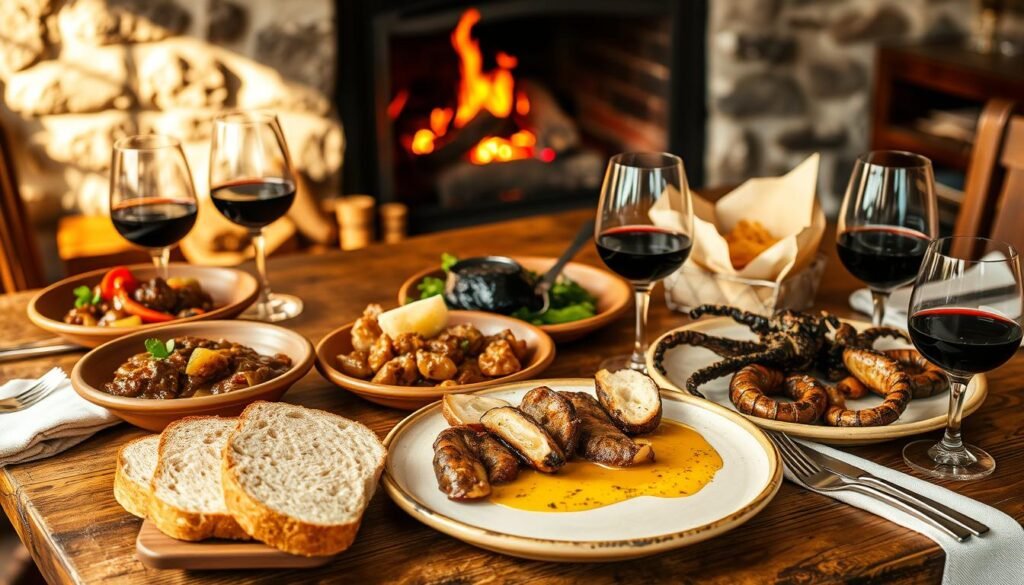
“A true Basque chef knows that ingredients must whisper the sea, the soil, and the soul of this land.” — Chef Marie Larretxea, Maison Basque
Ttoro: The Iconic Fisherman’s Soup
In family-run authentic Basque food spots, Ttoro is a must-try. It’s made with monkfish, mussels, and saffron. Each spoonful is like a taste of the Bay of Biscay, with bread crumbs and parsley on top.
Axoa: The Beloved Veal or Beef Dish
Axoa is a fiery dish made with veal or beef. It’s flavored with garlic, onions, and Espelette pepper. At Bistro Euskal, it’s served with toasted sourdough, warming your soul.
Marmitako: Tuna and Potato Stew
Marmitako comes from fishermen’s pots. It’s a mix of tuna, potatoes, tomatoes, and paprika. La Cantine Basque adds olive oil for a modern touch that respects tradition.
Piperade: The Colorful Bell Pepper Specialty
Piperade is a colorful dish with red, green, and yellow peppers. It’s mixed with tomatoes and onions. At Le Petit Béarn, it’s a daily favorite, showing off the region’s vibrant spirit.
| Dish | Key Ingredients | Top Spots |
|---|---|---|
| Ttoro | Monkfish, saffron, bread | Maison Basque |
| Axoa | Veal, Espelette pepper, garlic | Bistro Euskal |
| Marmitako | Tuna, potatoes, paprika | La Cantine Basque |
| Piperade | Bell peppers, tomatoes, onions | Le Petit Béarn |
Sweet Treasures: Desserts and Pastries of Saint-Jean-de-Luz
Step into the world of Basque desserts where every bite tells a story. Your first stop will be at Maison Adam, the legendary pâtisserie where gâteau Basque Saint-Jean-de-Luz has been perfected since 1660. The debate between its buttery layers filled with velvety pastry cream or tart black cherry jam still divides locals, a sweet rivalry you witness firsthand during a visit. These Saint-Jean-de-Luz pastries are more than desserts—they’re heirlooms passed through generations.
“The true gâteau must carry both flavors inside,” insisted Madame Dubois, the fifth-generation baker at L’Éclair de Marie, “but you decide which side you taste first!”
Beyond the iconic gâteau Basque, the region’s Basque desserts reveal hidden treasures. Consider mouchous—almond cookies created for Louis XIV’s wedding—still dusted with sugar in family kitchens. The honeyed tourons and kanougues (caramel candies with coffee or sea salt) add depth to each bite. Here’s the lineage of these masterpieces:
| Pastries | Story | Flavor |
|---|---|---|
| Mouchous | Wedding cookies from Louis XIV’s reign | Almond essence, subtle crunch |
| Tourons | Medieval market revival | Honeyed nuts, citrus zest |
| Kanougues | 19th-century port tradition | Caramel with dark chocolate or orange zest |
Winter brings creamy arros con leche (rice pudding) spiced with cinnamon, while summer showcases cherry clafoutis dripping with local fruit. Each visit to a family-owned pâtisserie feels like time travel—watching hands shape dough into perfect rounds, their motions as fluid as the nearby Atlantic waves.
You walk home, cradling a box of kanougues, their scent mingling with the salt air. As you savor a wedge of gâteau Basque in Saint-Jean-de-Luz beside the harbor, your mug of hot chocolate warms your hands. It mirrors a centuries-old ritual. These Saint-Jean-de-Luz pastries feel like love letters to tradition, whispered to you through sugar and history.
The Bounty of the Sea: Seafood Specialties in Saint-Jean-de-Luz
Walking the cobblestone quays at dawn, you see fishermen bring in sardines and amberjack. Their catch sparkles with salt. This coastal rhythm shapes every bite of the Basque seafood dishes. The Saint-Jean-de-Luz fishing tradition is a dance between ocean and plate perfected over centuries.
“A good catch is just the start,” says local chef Marine Larralde, “the real art is letting the sea’s gifts speak for themselves.”
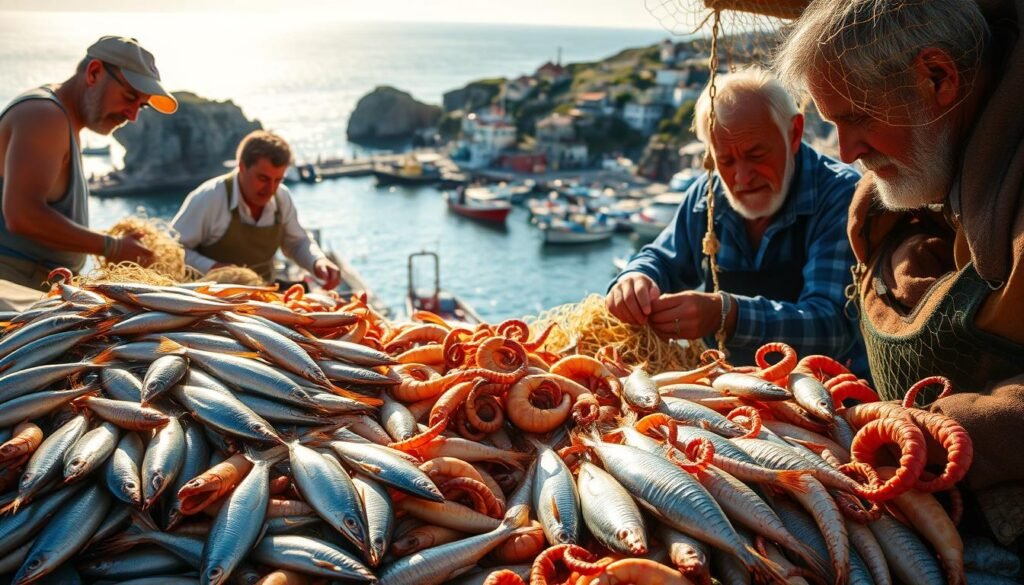
The Importance of Tuna and Sardines
Yellowfin tuna steaks are charred over charcoal or simmered into Marmitako stew. Sardines, those humble silversides, become gourmet delicacies. They’re smoked in clay ovens or packed in olive oil with garlic.
Freshly Caught Hake and Sea Bream
At market stalls, hake fillets shine with sea-kissed freshness. They’re often grilled with chili oil to highlight their buttery texture. For sea bream, try the recipe from this coastal-inspired dish, where their delicate flesh shines with lemon and herb brightness.
Seafood Conservation Practices
Local fishermen follow strict quotas and seasonal bans. This ensures sustainable Basque seafood thrives. Line-caught methods and partnerships with marine biologists protect spawning grounds. This balance lets every bite of Saint-Jean-de-Luz’s seafood feel like a pact between past and future.
Navigating Saint-Jean-de-Luz’s Vibrant Food Markets
Your mornings in Saint-Jean-de-Luz start like the locals do—at the Saint-Jean-de-Luz food markets. Les Halles, on Rue Gambetta, comes alive before 8 AM. You’ll hear the sound of crates and smell sea salt and peaches.
This Basque farmers market is more than a place to shop. It’s a daily tradition where old meets new.
Les Halles: The Covered Market Experience
Inside Les Halles, you’ll find the heart of Basque cuisine. Stalls fills with Bayonne ham, Ossau-Iraty cheese, and cherry tomatoes. Fishmongers display sardines and hake, catching the morning light.
Tip: Get to Les Halles early for the freshest shopping at Les Halles Saint-Jean-de-Luz.
- Fish section: Fresh catches from the Bay of Biscay
- Cheese counters: Sheep’s milk cheeses like Ossau-Iraty
- Produce aisles: Seasonal gems like Espelette peppers
Seasonal Produce Guide
Spring brings asparagus and Morelle du Verdon peas. Summer has sunburst tomatoes and Espelette peppers. Autumn offers mushrooms and butternut squash; winter has mandarins and cabbage.
Ask vendors for the “au top de la saison” (in peak season) items. They love to share.
Interacting with Local Vendors: Tips and Etiquette
Start with “Bonjour, qu’est-ce de saison?” (Hello, what’s in season?). This question opens doors. Your charcuterie seller gives you Bayonne ham after you praise his display.
Bargaining isn’t common here, but curiosity is. Always taste before buying. Cheese samples come with a squeeze of lemon, a tradition.
“The best strawberries are the ones that blush red to the stem,” says one vendor, handing me a basket of sun-ripened Gariguette strawberries.
Shopping here is more than buying food. It’s diving into Basque flavors. Every stall has a story, and the market’s pulse is its people, ready to share.
Culinary Travel to Saint-Jean-de-Luz: Planning Your Food-Focused Itinerary
Imagine walking by the sea, feeling the breeze, and ready to explore. This is what a Saint-Jean-de-Luz food tour is all about. To truly enjoy a Basque Country culinary vacation, mix planning with spontaneity. Pick a time that lets you enjoy every moment: a weekend for the best bits, or a week to really dive in.
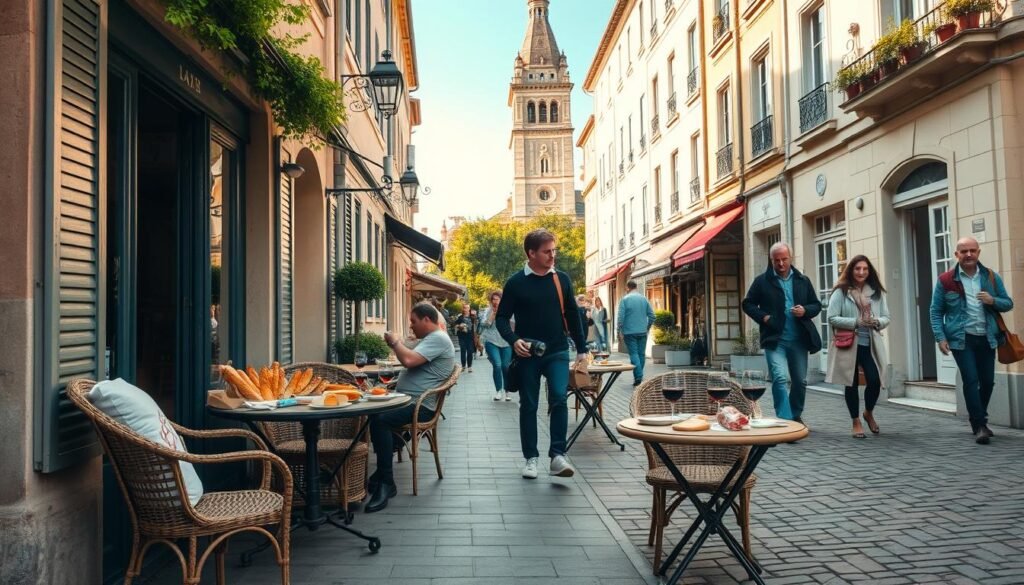
- 2-day immersion: Start with morning markets at Les Halles, then lunch at a marmitako place by the harbor. End with a Michelin-starred dinner at La Vague d’Or.
- 4-day exploration: Add a day trip to Bidart for cheese tours. Don’t forget a pintxos tour in Bayonne.
- Week-long journey: Mix coastal foraging with food-focused travel Saint-Jean-de-Luz. Include vineyard tastings and cooking workshops.
Visit from June to September for the best seafood. But September to November is less busy and has great autumn markets. Rent a bike to see vineyards or take trains to San Sebastián for pintxos. Stay at La Réserve for seasonal menus or a kitchen apartment to cook what you find.
Follow local rhythms. A fisherman says: “
Leave space for the unexpected: that sudden invitation to a cellar tasting, or the discovery of a hidden creperie
.”
For custom trips, our team at Epicurean Escape creates itineraries. Enjoy morning croissants by the harbor or explore the coast’s food landmarks. Saint-Jean-de-Luz is perfect for those who love to take their time. Let each bite be part of your Basque culinary journey.
Hands-On Experiences: Cooking Classes and Food Workshops
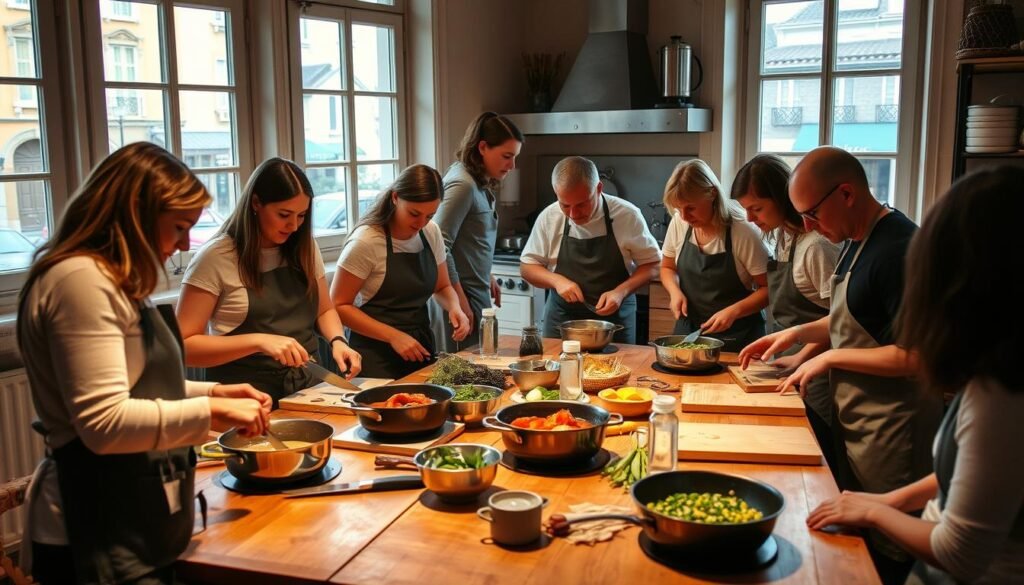
Your hands smell like caramelized onions after you make piperade in a Basque cooking class. Saint-Jean-de-Luz invites you to go beyond just tasting. You’ll learn to make dishes like piperade and pintxos, becoming part of Basque culinary traditions.
At Saint-Jean-de-Luz culinary workshops, experts like Ateliers de Cuisine Basque teach you old-school cooking. You can pick from short sessions or longer classes on making jambon-beurre sandwiches. Everyone, from beginners to pros, leaves with new skills and recipes.
Master the Craft: Specialized Sessions
- Chocolate workshops tracing the region’s cocoa traditions
- Pintxos creation labs emphasizing balance of flavors and presentation
- Seasonal preserving classes using market-fresh produce
Many workshops offer English instruction. Book through Epicurean Escape’s curated programs for easy arrangements.
Create Together: Family Adventures
| Activity | Highlights | Ideal For |
|---|---|---|
| Gâteau Basque Crafting | Layering almond and cherry fillings with local bakers | Families with kids 8+ |
| Market Scavenger Hunt | Learning to identify peak-ripe tomatoes and espelette peppers | Families seeking interactive exploration |
Every class ends with a treat to take home—a jar of homemade jam or a basket of biscochuelas. These classes are more than lessons; they’re a way to connect with Basque culture. The joy of learning to cook Basque food stays with you long after you leave.
Drinking Traditions: Basque Cider, Wine, and Spirits
Your first taste of Basque cider at a lively Basque cider house in Saint-Jean-de-Luz becomes unforgettable. At the sagardotegi you visit, cider pours from ancient barrels in the txotx ritual. You raise your glass, joining the crowd as laughter and the tangy rush of cider bring everyone together in celebration.
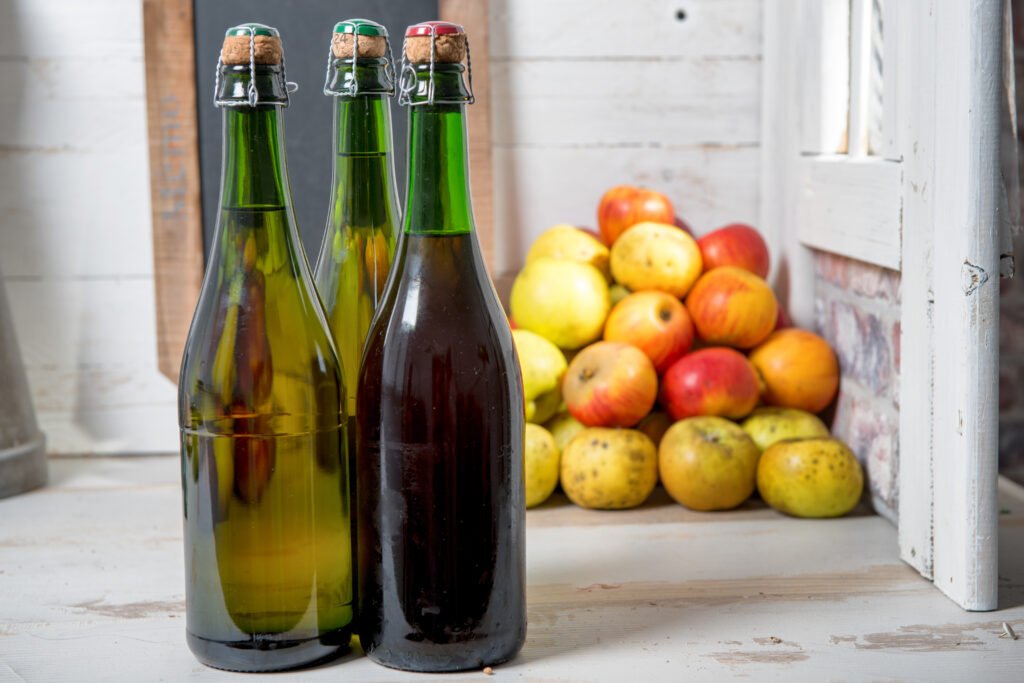
Exploring the Irouléguy wine region, you’ll amaze by its rugged beauty. The hills grow grapes like Tannat and Petit Courbu. The red wines are bold, while the whites are crisp and refreshing. Try Domaine d’Aspé or Château d’Espelette at Saint-Jean-de-Luz’s wine bars.
- Patxaran: Bittersweet sloe berry liqueur, stirred with tonic at sunset terraces.
- Izarra: Herbal green and yellow liqueurs served as digestifs with a hint of anise.
- Txakoli: Crisp sparkling white poured dramatically from high above glasses, a must at beachfront taverns.
| Drink | Origin | Signature Flavor |
|---|---|---|
| Basque Cider | Cider Houses | Fresh apple acidity |
| Irouléguy Red | Irouléguy AOC | Smoky, tannic depth |
| Patzaran | Basque Country | Dark fruit and almond notes |
From rustic bars to modern cocktail spots, Basque drinks tell stories. They’re more than beverages; they’re the heart of Basque unity.
Dining Etiquette: Understanding Meal Times and Customs
Exploring Basque dining customs is like discovering a hidden treasure in Saint-Jean-de-Luz. Your first lunch there shows you the importance of timing. Meals are sacred, with lunch between 12:30 and 2:30 PM and dinner after 8 PM. The dishes are filled with marmitako or grilled hake.
Respecting tradition is key in French Basque dining. Courses come in order, like a symphony. Skipping the starter is a big no-no. Reservations are essential, especially for top spots that close at 2 PM. A small tip, like €2 for a 20€ meal, shows appreciation for great service.
- Meal times in Saint-Jean-de-Luz are relaxed: breakfast might include gâteau basque or omelettes.
- Afternoon coffee is a ritual with café au lait and pain de campagne.
- Knowing phrases like “Une table pour deux, s’il vous plaît” or “À emporter?” helps you connect with locals.
Learning the local language makes you feel more at home. “Sur plancha” means grilled, and “pintxos” are skewered snacks, unlike Spanishtapas. These details make you feel like a true guest.
Every meal here has a story. By following these customs, you’re not just eating—you’re part of a long tradition. Bon appétit!
Beyond Saint-Jean-de-Luz: Day Trips for Food Enthusiasts
Exploring the Basque Country food trips reveals layers of flavor and tradition just beyond Saint-Jean-de-Luz’s shores. Your journey north to Biarritz unveils a Belle Époque pastry scene. Here, buttery madeleines and oyster bars line the harbor. South across the Spanish border, San Sebastián’s pintxos bars beckon with toothpick-tied delicacies like marinated anchovies on toasted bread.
Espelette’s red peppers blaze vibrantly from farmhouse walls, drying into the spice that flavors local stews; while Pyrenees foothills hide sheep farms. Here, garbure soups and creamy idiazábal cheese await discovery. Each destination offers a piece of the Basque food tourism puzzle, showing how landscapes shape flavors.
- Biarritz: Seafood markets and Art Nouveau patisseries
- San Sebastián: Pintxos crawl through La Ribera’s historic quarter
- Espelette: Pepper festivals and spice-infused farm visits
Rental cars or trains make these culinary excursions from Saint-Jean-de-Luz accessible. Combining stops into themed routes—like the “Seafood Odyssey” or “Pepper Trail”—deepens the Basque culinary narrative. A guided tour with local experts ensures you savor hidden gems like family-run cider houses pouring aged sidra from tall barrels. These journeys don’t just add variety—they reveal how Saint-Jean-de-Luz’s flavors resonate across regions, creating a symphony of shared heritage. Every bite becomes a passport to the heart of Basque food tourism.
Conclusion: Embracing the Authentic Flavors of Saint-Jean-de-Luz
As the sun sets behind the Pyrenees, its golden light kisses the Bay of Biscay. You sit at a wooden table, savoring grilled turbot—warm, drizzled with olive oil and sprinkled with sea salt. In this quiet moment, you feel the true spirit of Saint-Jean-de-Luz.
Traveling here is more than just eating. It’s diving into Basque traditions. Every meal is a story of land, sea, and history.
The smell of wood-fired txakoli wine fills the air. Market stalls are full of red peppers. This town offers a real taste of Basque food.
At family taverns, Axoa simmers in clay pots. Fishermen worked hard, unloading their catch. These moments show the town’s heart.
Every bite here is filled with history. Whether it’s a gâteau basque or laughter over pintxos, it’s all part of the experience.
Basque gastronomy tourism is all about being spontaneous. Explore the fishmongers, learn from chefs, or follow the smell of roasting peppers. This is where traditions come alive.
A vendor gives you Idiazábal cheese wrapped in chestnut leaves. It is a lesson in preserving traditions.
When you finish your marmitako, remember: Saint-Jean-de-Luz loves curiosity. Let your senses guide you. The best moments are the ones you don’t plan.
Enjoy a sunlit lunch at a fisherman’s shack or a chat over sagardoa. These moments capture the essence of Basque cuisine. Bon voyage, and bon appétit.

